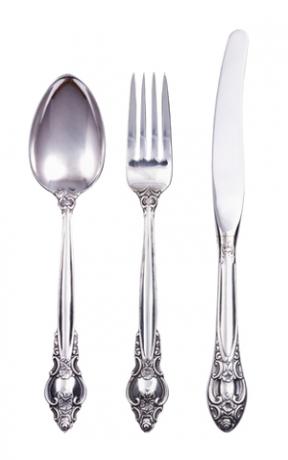A chemical element is nothing more than a group of atoms that have the same number of protons in their nucleus (atomic number). Thus, when we analyze certain atoms and realize that their atomic number is the same, we are sure that it is a chemical element.
When we study the periodic table, we see that 118 different elements are represented on it. Therefore, we know that the human being knows that there are only 118 atoms with different numbers of protons inside their nuclei.
Each chemical element has a group of properties and applications, which, in turn, are quite varied and important. In this text, we will pay special attention to the chemical element called Silver.
THE Silver is represented by the acronym "Ag" due to the origin of its name, which comes from the Latin argentum. See how this element is called in other languages:
Spanish: Plata
English: Silver
Italian: Argento
French: Argent
Japanese: Gin
Silver is a metal extremely known and used all over the world. The history of its use dates back to
3000 a. Ç. For many, many years, this element, together with gold, was synonymous with wealth. When reading the Biblical Old Testament, for example, it is possible to verify that many characters in the Bible they became known for having a lot of gold and silver, which shows how this metal has had value for a long time. time.Interestingly, there was a time when silver had more financial value than gold. This happened between the years of 1780 to 1580 BC Ç. The devaluation of silver only began to occur when it began to be found much more easily than gold. Today is this metal is found mainly in the South America, United States, Australia, Mexico and Norway.
Silver can have three origins: natural (found in nature), industrial and synthetic (produced in the laboratory):
Natural: Silver can be found in its pure form or associated with other materials. In nature, there are more than 60 different ores that have silver in their composition;
Industrial: it is obtained from the processing of materials such as lead, copper and zinc;
Synthetic: It is obtained from chemical reactions with salts that have silver in their constitution, such as silver nitrate, which, when reacting with copper, gives rise to a salt and pure metallic silver. See the equation that represents the process:
Cu + 2AgNO3 → Cu (NO3)2 + 2 Ag
See below the main characteristics and uses of Silver:
Do not stop now... There's more after the advertising ;)
a) Main characteristics of silver
It is a metal that has a characteristic color (silver white) it is a metallic shine very intense. When silver comes into contact with oxygen, a chemical reaction occurs with the formation of silver oxide, which is a black material that can be easily removed through the process of part polish.
silver presents atomic number equal to 47, that is, inside the nucleus of the silver atoms we find 47 protons (positively charged particles) and 47 electrons (negatively charged particles) In yours atomic orbitals. This metal is located on the periodic table in the so-called group 11 or family IB and has the following electronic distribution:
1s2 2s2 2p6 3s2 3p6 3d10 4s2 4p6 4d10 5s1
In addition to the foregoing, there are specificities of silver:
Physical State: Solid (T = 298K or 25 OÇ);
Density: 10.490 (g/cm3);
Melting point: 961.93 OÇ;
Boiling Point: 2212 OÇ;
Transition Metal (belonging to a B family);
It's soft;
It is ductile (can form threads);
It is malleable (can form a blade);
Its crystal structure is face-centered cubic (the way the atoms are arranged);
Hardness: 3.25 mohs (this quantity evaluates the hardness of the material, which is the ability to scratch. Thus, silver is less hard than granite (granite scratches silver), for example.);
When burned, it produces a lilac colored flame;
It is stable when exposed to air;
It's a good conductor of electricity.
Comments:
When exposed to ozone, silver loses its characteristic shine;
Toxicity — this is a metal that is toxic to humans. When a person is contaminated with silver, he develops an intoxication called argyria, in which silver is deposited in the mucous membranes.
b) Main uses of silver
Used for the production of jewelry in general and decorative objects (always associated with copper, in greater or lesser quantity);
Cutlery manufacture;

Silverware made of silver
Production of musical instruments;
Manufacture of car radiators;
Manufacture of coins;
In the dental field (amalgam for restoration, for example);
Formation of alloys for soldering;
Production of electrical contacts;
Production of high-capacity batteries;
Production of paintings used on printed circuits;
Production of explosives (silver present in inorganic salts);
Used in conventional photography (silver present in inorganic salts);
Used to cause rain (silver present in inorganic salts);
Serves as a cement for glass (silver present in inorganic salts);
Used in the treatment of irritation of the mucous membranes of the mouth and throat (silver present in inorganic salts);
Used as an anti-irritant agent for the membranes of the eyes, ear, nose and throat (silver present in inorganic salts).
By Me. Diogo Lopes Dias
Would you like to reference this text in a school or academic work? Look:
DAYS, Diogo Lopes. "Silver"; Brazil School. Available in: https://brasilescola.uol.com.br/quimica/prata.htm. Accessed on June 27, 2021.



